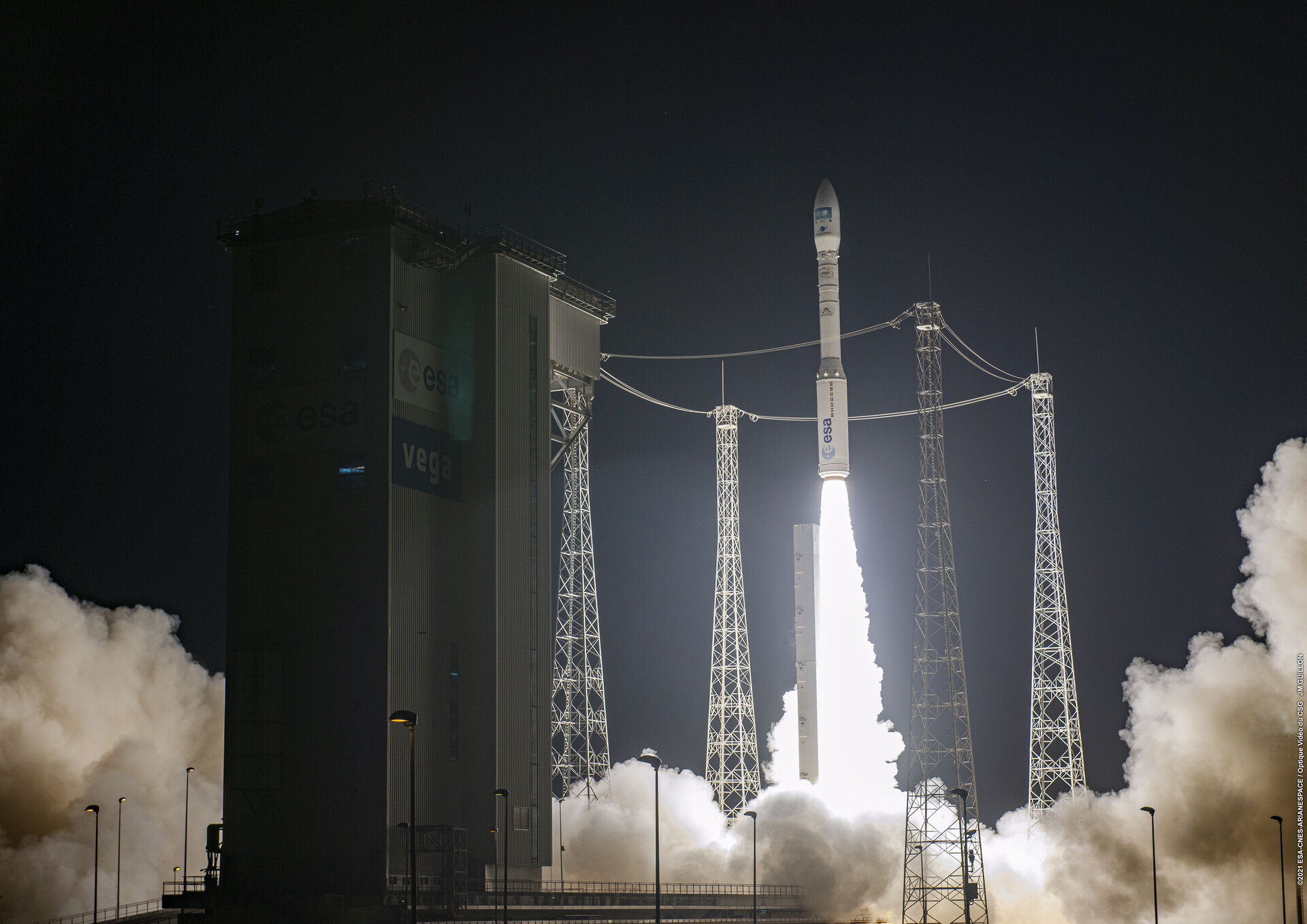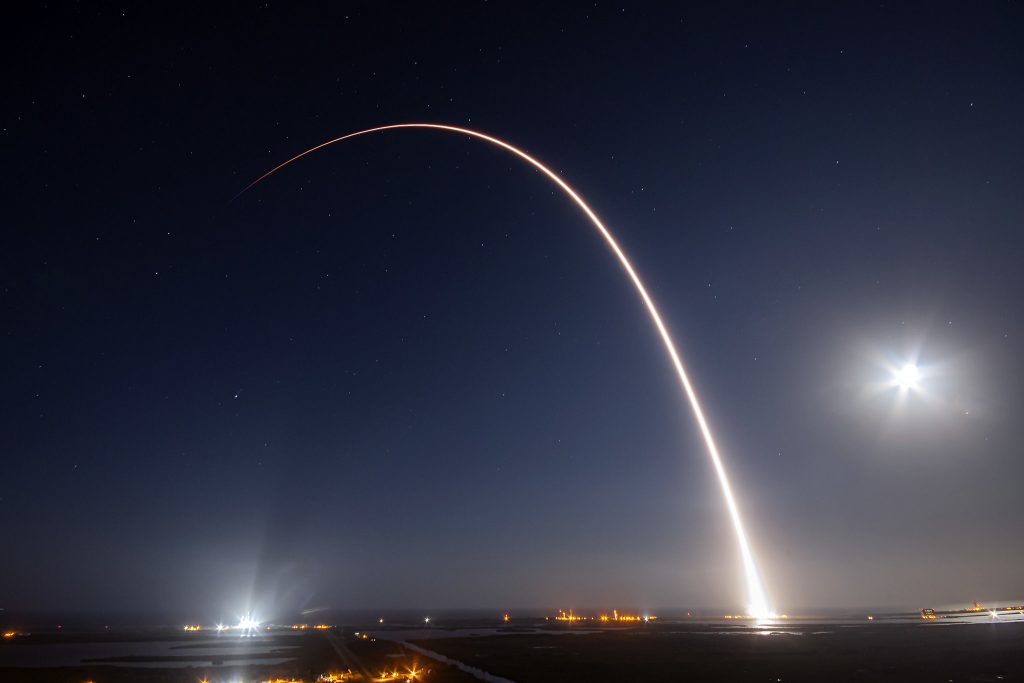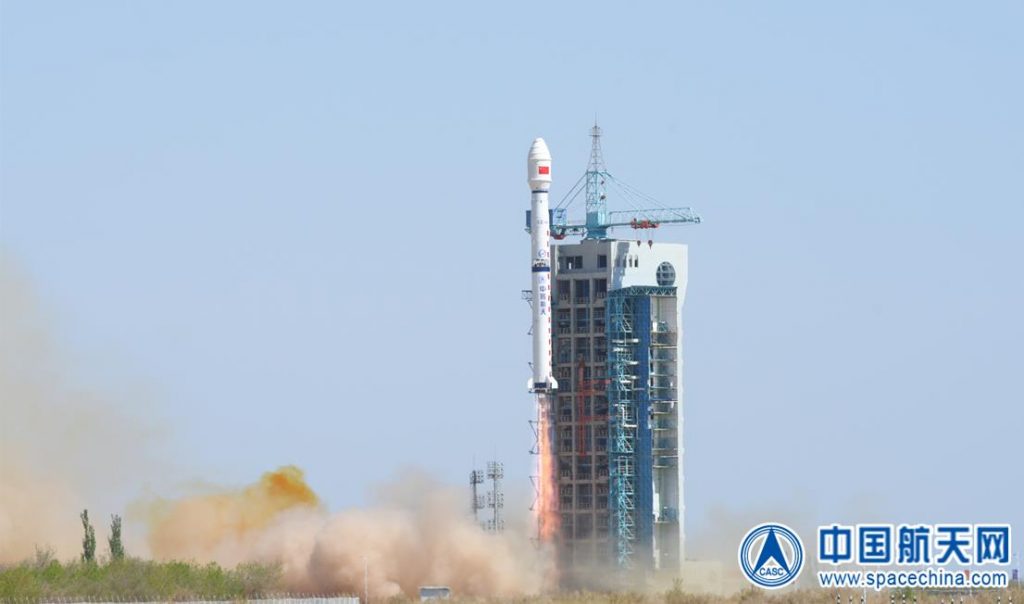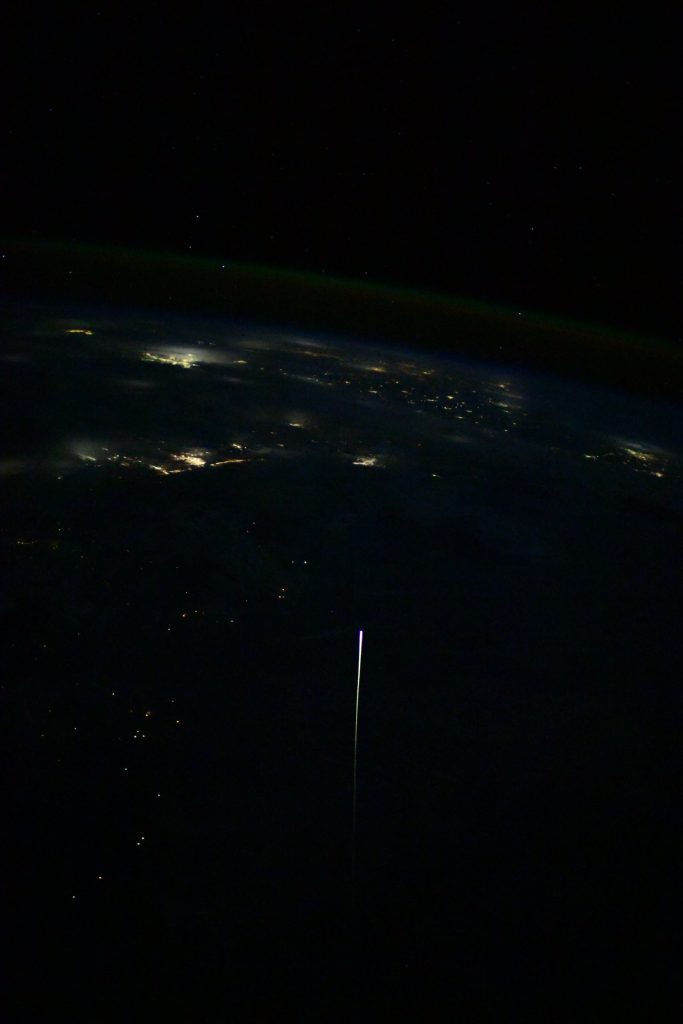This week’s Rocket Roundup episode features a remarkable triple header of launches in just over 100 minutes, plus one other launch and the conclusion of the first operational Commercial Crew mission including the first night splashdown of a crewed spacecraft in 53 years.
Media
Transcript
Hello, and welcome to the Daily Space. I am Dr. Pamela Gay, and most weekdays, the CosmoQuest team is here putting science in your brain. Today, however, is for Rocket Roundup. Let’s get to it, shall we?
April 29 was a super busy day for spaceflight fans with three launches occurring in just over 100 minutes.
First up at 01:50 UTC, Arianespace’s Vega rocket lifted off from the pad in Kourou, French Guiana for VV18. This was Vega’s return-to-flight mission after the failures of flights 15 and 17. And no, we didn’t skip a mission; Vega flight 16 was successful. It just had the misfortune of being squished between two not-so-nominal launches.

For a bit of history, flight 15 failed in July 2019 due to a structural problem with the second stage, and flight 17 failed in November 2020 because — and I cannot make this up — someone reversed cables on the fourth stage’s guidance system, resulting in the opposite of the intended maneuvers and the rocket spinning out of control.
Now that I’ve talked about the reasons why this launch had a few people on edge, let’s focus on the payloads. For this flight, everything was perfectly nominal, and Pleiades Neo 3, the primary spacecraft, was successfully inserted into orbit just under an hour after launch. After two more burns that took 101 minutes, five additional CubeSats separated from the fourth stage.
Pleiades Neo 3 is the first of a constellation of high-resolution commercial imaging spacecraft. When the full constellation of four spacecraft is in orbit, it will allow for images to be taken of the same site twice a day, and the company will support requests for images to be processed 30 minutes after acquisition.
The five CubeSat payloads include two AIS ship tracking satellites for Spire, a spectrum survey satellite for Aurora Insight, a satellite for the Norwegian Space Agency, and an Internet of Things satellite for Eutelsat.
The next launch in the triple-header was a Big Deal.
On March 29 at 03:23 UTC, China launched a Long March 5B carrying the core module for the China Space Station from the Wenchang Satellite Launch Center on China’s Hainan Island. This high-profile launch was broadcast live in real-time online by China Central Television, the state television network.

This was only the second launch for the Long March 5B; it first launched about a year ago. It’s a bit different from the Long March 5. By omitting the large second stage from the Long March 5, the Long March 5B can launch really massive objects into low Earth orbit but no further. This also makes it a one-and-a-half stage vehicle just like the Atlas rocket that launched the Mercury capsules into orbit back in the 1960s. Both the rocket core and boosters are ignited on the ground, and the boosters are jettisoned when they have used up their propellant. The rocket core stage goes all the way into orbit with the payload.
The core module is named Tianhe, which literally translates to “Harmony of the Heavens”. The module is massive, weighing 22.5 metric tons (or 11,250 2-liter soda bottles), and it completely filled the cavernous fairing of the Long March 5B. The space inside the fairing is 20.5 meters long and 5.2 meters wide; our team thinks you can fit four school buses inside.
Tianhe itself looks externally like the Mir Core module with ISS-style solar panels on the sides. China’s entire space program is heavily influenced by Russia’s space program. The Chinese crewed spacecraft is essentially an adaptation of Soyuz, and their previous space stations were similar to the Soviet Salyut stations.
On the inside, the station is laid out reminiscent of the International Space Station module, with a clearly defined bottom and top and lockers on the sides. There are only so many ways to build a space station, so they all kind of end up looking the same. The Chinese station has two axial docking ports, one on each end, and four radial docking ports in a hub on the narrow end of the module. The docking ports resemble the ISS’s International Docking System Standard ports. (The technical specifications are freely available online for anyone to download, so you too can download a copy and build your own International Docking System port if you want.) Shenzhou — the Chinese crewed spacecraft — has docked to ports like this one on the previous Chinese space stations, the Tiangong 1 and 2. There is also an airlock for spacewalks in the core module.
China has an ambitious schedule of the future crew, resupply, and additional module launches for the next 18 months to fully outfit the station and populate it. The first of these is the Tianzhou 2 resupply spacecraft in May, followed by the crewed Shenzhou 12 mission later in June. Two other “Laboratory Cabin Modules” named Wentian and Mengtian will be launched on future Long March 5B’s in 2022. We’ll have reports for those launches after they occur.
One more note on this launch: according to Chinese sources, the core stage was supposed to conduct a deorbit burn to hasten its return to Earth. This would have been accomplished by venting excess propellants at just the right time and direction to slow down its orbit. As the core stage was still being tracked in its insertion orbit many hours after launch, the deorbit burn apparently did not happen. The core stage will have an uncontrolled reentry somewhere between 41 North and 41 South latitude, based on the inclination of the orbit, in the next days/weeks. This will be a major event wherever it occurs.
The last Long March 5B core stage missed reentering over New York City by about two minutes of predicted reentry time. That core stage ended up reentering over the Pacific Ocean just off the Ivory Coast and showering a village with debris. As of May 4, this latest core stage was expected to reenter on May 9th at 04:37 UTC give or take about a day, so basically anywhere on Earth sometime next week. [Ed note: The core stage fell into the Indian Ocean at 03:24 UTC on May 9, near 72.47 degrees East and 2.65 degrees North.]

Finally in the triple header, on April 29 at 03:44 UTC, SpaceX launched a Falcon 9 from SLC-40 at Cape Canaveral Space Force Station in Florida. Booster 1060 took another sixty Starlink satellites to orbit for the Starlink L-24 mission. This marks 1505 Starlink version 1.0 satellites launched, so the first shell of the Starlink constellation is now complete.
For those of you keeping score at home: this was the seventh mission for this particular booster, and both of the fairings were reused. Booster 1060 successfully landed on the drone ship Just Read The Instructions, and both fairings were recovered from the water and returned to port.
For our last launch of the week, on April 30 at 07:25 UTC, China launched another rocket — this time a Long March 4C rocket from the Jiuquan Satellite Launch Center in northwestern China. Onboard was the Yaogan 34 mission.

This was the first of a new series of remote sensing satellites likely for military applications as the generic name “Yaogan” translates to “Remote Observing”. The purpose of this specific Yaogan satellite was described as an optical remote sensing satellite, mainly used in territorial survey, urban planning, land right confirmation, road network design, crop yield estimation, disaster prevention, and mitigation, and other fields.
Finally, on May 2 at 02:37 UTC, Crew Dragon Resilience undocked from the ISS after 169 days in space. Onboard were Expedition 64/Crew-1 astronauts Michael Hopkins, Victor Glover, Soichi Noguchi, and Shannon Walker. Originally scheduled for April 28, the undocking was pushed back several days due to bad weather in the recovery zone in the Gulf of Mexico, just off the coast of the Florida Panhandle.
On May 2, the undock-minus-six-hours weather briefing was good, and the crew suited up and boarded the capsule. Once the hooks on the SpaceX Docking System were driven out, Crew Dragon Resilience performed a burn with its Draco thrusters to begin moving away from the docking port. Because the capsule departed during orbital night, each of the thruster burns was clearly visible on the NASA webcast.

Once the Crew Dragon was safely away from the ISS, it performed three more burns using all of its thrusters to increase the rate of departure from the ISS. Then Resilience spent the next few orbits ten kilometers below the ISS preparing for the deorbit burn. This burn lasted sixteen minutes and 23 seconds and set the capsule up for a precision landing just off the coast of Panama City, Florida. An image from ESA astronaut ThomasPesquet taken aboard the ISS shows the bright streak of Resilience reentering the atmosphere in the Gulf of Mexico.
The NASA webcast used the infrared camera on a WB-57 aircraft to track the capsule through the entry, drogue chute deploy, and the main chute deploy, and the feed showed the trail of the capsule through reentry all the way down to splashdown. Splashdown happened at 07:56 UTC, early morning local time.
Crew Dragon Resilience was quickly lifted out of the water in the pitch darkness and hoisted onto the deck of GO Navigator, the primary recovery vessel. First, a small boat headed to the capsule, and a specially trained crewmember climbed on top of the just-landed capsule and attached a lift harness. Right before the capsule was lifted out of the water, the specialist jumped into the water and was picked up by the small boat.
This was the first night recovery of an American crewed spacecraft since the recovery of Apollo 8 in 1968. The four astronauts, Noguchi, Walker, Glover, and Hopkins, were all smiles and thumbs up after they disembarked the capsule.

After a medical check in GO Navigator’s onboard clinic, the crew members boarded a helicopter and were flown back to NASA Houston. GO Navigator and the capsule took the long way around the tip of Florida to Port Canaveral’s Poseidon Wharf. Because the Crew Dragon is still loaded with the hazardous hypergolic fuel used for its Draco and SuperDraco thrusters, the capsule is being taken to Poseidon Wharf rather than the usual North Cargo pier as Poseidon is more isolated in case anything goes wrong.
Once unloaded from GO Navigator, Resilience will be taken to the Crew Dragon processing facility at Area 58 on Cape Canaveral Space Force Station to off-load the hypergolic fuel and undergo further processing and preparation for its next trip to space. The capsule’s next flight is already penciled in for no earlier than September 2021 on the Inspiration 4 mission, which will be the first all civilian space mission.
Statistics
To wrap things up, here’s a running tally of a few spaceflight statistics for the current year:
The number of space toilets remains steady, as the addition of the Chinese space station’s toilet was offset when Crew-1 returned to Earth.
Toilets currently in space: 6: 3 installed on ISS, 1 on the Crew Dragon, 1 on the Soyuz, and 1 on Tianhe
Total 2021 orbital launch attempts: 38, including 1 failure
Total satellites from launches: 924

I keep track of orbital launches by where they launched from, also known as spaceport. Here’s that breakdown:
USA: 14
China: 10
Kazakhstan: 4
Russia: 3
New Zealand: 2
French Guinea: 1
India: 1
Random Space Fact
Your random space fact for this week is that NASA engineer Judith Love Cohen worked on an engineering problem for one of the Apollo missions while she was in labor with her son, actor Jack Black.
Learn More
Arianespace Launches Pléiades Neo 3 Onboard First Vega of 2021
- PDF: Arianespace launch kit
- Vega Flight VV15: Findings of the Independent Inquiry Commission’s investigations (Arianespace)
- Loss of Vega Flight VV17: Identification of source of anomaly and establishment of Inquiry Commission (Arianespace)
- Lemur-2 info page (Gunter’s Space Page)
- AII info page (Gunter’s Space Page)
- NORSAT 3 info page (Gunter’s Space Page)
- ELO Alpha info page (Gunter’s Space Page)
- Launch video
China Sends Up New Tianhe Space Station Core Module
- Planned space station details made public (China Daily)
- China launches Tianhe space station core module into orbit (Xinhua)
- CZ-5-8 Data Sheet (Space Launch Report)
- Huge rocket looks set for uncontrolled reentry following Chinese space station launch (SpaceNews)
- Bridenstine criticizes China for uncontrolled rocket reentry (SpaceNews)
- Launch video
SpaceX Starlink-24 Launch Succeeds
- Launch video
China Launches Next Yaogan Satellite Onboard Long March 4C
- Space China press release (Chinese)
- Yaogan 9 info page (Gunter’s Space Page)
- Launch video
Crew-1 Returns to Earth in Nighttime Splashdown
- NASA press release
Random Space Fact: Judith Love Cohen
Credits
Host: Dr. Pamela Gay
Writers: Elad Avron, Dave Ballard, Gordon Dewis, Pamela Gay, Beth Johnson, Erik Madaus, Ally Pelphrey, and Annie Wilson
Audio and Video Editing: Ally Pelphrey
Content Editing: Beth Johnson
Executive Producer: Pamela Gay
Intro and Outro music by Kevin MacLeod, https://incompetech.com/music/


 We record most shows live, on Twitch. Follow us today to get alerts when we go live.
We record most shows live, on Twitch. Follow us today to get alerts when we go live.